Ancient Russia in the medieval world was widely famous for its craftsmen. At first, among the ancient Slavs, the craft was domestic in nature - everyone dressed skins for themselves, tanned leather, weaved linen, sculpted pottery, made weapons and tools. Then the artisans began to engage only in a certain craft, prepared the products of their labor for the entire community, and the rest of its members provided them with food. Agriculture, furs, fish, beast. And already in the period of the early Middle Ages, the production of products on the market began. At first it was custom-made, and then the goods began to go on free sale.
Talented and skilled metallurgists, blacksmiths, jewelers, potters, weavers, stone-cutters, shoemakers, tailors, representatives of dozens of other professions lived and worked in Russian cities and large villages. These simple people made an invaluable contribution to the creation of the economic power of Russia, its high material and spiritual culture.
The names of the ancient artisans, with few exceptions, are unknown to us. Objects preserved from those distant times speak for them. These are both rare masterpieces and everyday things, in which talent and experience, skill and ingenuity are invested.
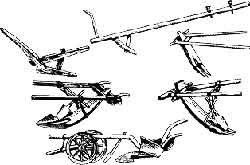 Blacksmiths were the first ancient Russian professional artisans. The blacksmith in epics, legends and fairy tales is the personification of strength and courage, goodness and invincibility. Iron was then smelted from swamp ores. Ore was mined in autumn and spring. It was dried, fired and taken to metal-smelting workshops, where metal was obtained in special furnaces. During excavations of ancient Russian settlements, slags are often found - waste products of the metal-smelting process - and pieces of ferruginous bloom, which, after vigorous forging, became iron masses. The remains of blacksmith workshops were also found, where parts of forges were found. The burials of ancient blacksmiths are known, in which their tools of production - anvils, hammers, tongs, chisels - were placed in their graves.
Blacksmiths were the first ancient Russian professional artisans. The blacksmith in epics, legends and fairy tales is the personification of strength and courage, goodness and invincibility. Iron was then smelted from swamp ores. Ore was mined in autumn and spring. It was dried, fired and taken to metal-smelting workshops, where metal was obtained in special furnaces. During excavations of ancient Russian settlements, slags are often found - waste products of the metal-smelting process - and pieces of ferruginous bloom, which, after vigorous forging, became iron masses. The remains of blacksmith workshops were also found, where parts of forges were found. The burials of ancient blacksmiths are known, in which their tools of production - anvils, hammers, tongs, chisels - were placed in their graves.
Old Russian blacksmiths supplied plowmen with coulters, sickles, scythes, and warriors with swords, spears, arrows, battle axes. Everything that was necessary for the economy - knives, needles, chisels, awls, staples, fishing hooks, locks, keys and many other tools and household items - were made by talented craftsmen.
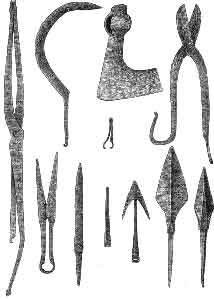
Old Russian blacksmiths achieved special art in the production of weapons. Unique samples old Russian craft X century are objects found in the burials of the Chernaya Mohyla in Chernihiv, necropolises in Kiev and other cities.
A necessary part of the costume and attire of an ancient Russian person, both women and men, were various jewelry and amulets made by jewelers from silver and bronze. That is why clay crucibles, in which silver, copper, and tin were melted, are often found in ancient Russian buildings. Then the molten metal was poured into limestone, clay or stone molds, where the relief of the future decoration was carved. After that, an ornament in the form of dots, cloves, circles was applied to the finished product. Various pendants, belt plaques, bracelets, chains, temporal rings, rings, neck torcs - these are the main types of products of ancient Russian jewelers. For jewelry, jewelers used various techniques - niello, granulation, filigree filigree, embossing, enamel.
The blackening technique was rather complicated. First, a “black” mass was prepared from a mixture of silver, lead, copper, sulfur and other minerals. Then this composition was applied to bracelets, crosses, rings and other jewelry. Most often depicted griffins, lions, birds with human heads, various fantastic animals.
Graining required completely different methods of work: small silver grains, each of which was 5-6 times smaller than a pinhead, were soldered to flat surface products. What labor and patience, for example, was worth soldering 5,000 such grains to each of the kolts that were found during excavations in Kiev! Most often, granulation is found on typical Russian jewelry - lunnitsa, which were pendants in the form of a crescent.
If instead of grains of silver, patterns of the finest silver, gold wires or strips were soldered onto the product, then a filigree was obtained. From such threads-wires, sometimes an incredibly intricate pattern was created.
The technique of embossing on thin gold or silver sheets was also used. They were strongly pressed against a bronze matrix with the desired image, and it was transferred to a metal sheet. Embossing performed images of animals on kolts. Usually it is a lion or a leopard with a raised paw and a flower in its mouth. Cloisonne enamel became the pinnacle of ancient Russian jewelry craftsmanship.
The enamel mass was glass with lead and other additives. The enamels were different colors, but in Russia they were especially fond of red, blue and green. Enamel jewelry went through a difficult path before becoming the property of a medieval fashionista or a noble person. First, the entire pattern was applied to the future decoration. Then they put on him thinnest sheet gold. Partitions were cut from gold, which were soldered to the base along the contours of the pattern, and the spaces between them were filled with molten enamel. It turned out an amazing set of colors that played and shone under the sun's rays. different colors and shades. The centers for the production of jewelry from cloisonné enamel were Kiev, Ryazan, Vladimir...
![]() And in Staraya Ladoga, in the layer of the 8th century, an entire industrial complex was discovered during excavations! The ancient Ladoga residents built a pavement of stones - iron slags, blanks, production wastes, fragments of foundry molds were found on it. Scientists believe that a metal-smelting furnace once stood here. The richest treasure trove of handicraft tools, found here, is apparently associated with this workshop. The hoard contains twenty-six items. These are seven small and large pliers - they were used in jewelry and iron processing. For the manufacture of jewelry used a miniature anvil. An ancient locksmith actively used chisels - three of them were found here. Sheets of metal were cut with jewelry scissors. Drills made holes in the tree. Iron objects with holes were used to draw wire in the production of nails and rook rivets. Jewelry hammers, anvils for chasing and embossing ornaments on silver and bronze jewelry were also found. Finished products of an ancient craftsman were also found here - a bronze ring with images of a human head and birds, rook rivets, nails, an arrow, knife blades.
And in Staraya Ladoga, in the layer of the 8th century, an entire industrial complex was discovered during excavations! The ancient Ladoga residents built a pavement of stones - iron slags, blanks, production wastes, fragments of foundry molds were found on it. Scientists believe that a metal-smelting furnace once stood here. The richest treasure trove of handicraft tools, found here, is apparently associated with this workshop. The hoard contains twenty-six items. These are seven small and large pliers - they were used in jewelry and iron processing. For the manufacture of jewelry used a miniature anvil. An ancient locksmith actively used chisels - three of them were found here. Sheets of metal were cut with jewelry scissors. Drills made holes in the tree. Iron objects with holes were used to draw wire in the production of nails and rook rivets. Jewelry hammers, anvils for chasing and embossing ornaments on silver and bronze jewelry were also found. Finished products of an ancient craftsman were also found here - a bronze ring with images of a human head and birds, rook rivets, nails, an arrow, knife blades.
Finds at the settlement of Novotroitsky, in Staraya Ladoga and other settlements excavated by archaeologists indicate that already in the 8th century the craft began to become an independent branch of production and was gradually separated from agriculture. This circumstance had importance in the process of class formation and the creation of the state.
If for the 8th century we know so far only a few workshops, and in general the craft was of a domestic nature, then in the next, 9th century, their number increases significantly. Masters now produce products not only for themselves, their families, but for the entire community. Long-distance trade relations are gradually strengthening, various products are sold on the market in exchange for silver, furs, agricultural products and other goods.
In the ancient Russian settlements of the 9th-10th centuries, archaeologists have unearthed workshops for the production of pottery, foundry, jewelry, bone carving and others. Improvement of tools, invention new technology made it possible for individual members of the community to produce various things needed on the farm alone, in such quantities that they could be sold.
The development of agriculture and the separation of crafts from it, the weakening of tribal ties within communities, the growth of property inequality, and then the emergence of private property - the enrichment of some at the expense of others - all this formed a new mode of production - feudal. Together with him, the early feudal state gradually arose in Russia.Forging metal in Russia
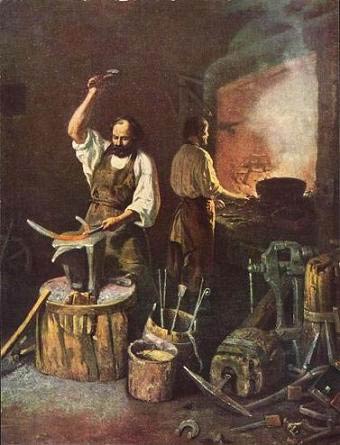 In Russia, iron was known to the early Slavs. Most old method metalworking is forging. At first, ancient people beat spongy iron with mallets in a cold state in order to "squeeze the juice out of it", i.e. remove impurities. Then they guessed to heat the metal and give it the desired shape. In the 10th - 11th centuries, thanks to the development of metallurgy and other crafts, the Slavs had a plow and a plow with an iron plowshare. On the territory of ancient Kiev, archaeologists find sickles, door locks and other things made by the hands of blacksmiths, gunsmiths and jewelers.
In Russia, iron was known to the early Slavs. Most old method metalworking is forging. At first, ancient people beat spongy iron with mallets in a cold state in order to "squeeze the juice out of it", i.e. remove impurities. Then they guessed to heat the metal and give it the desired shape. In the 10th - 11th centuries, thanks to the development of metallurgy and other crafts, the Slavs had a plow and a plow with an iron plowshare. On the territory of ancient Kiev, archaeologists find sickles, door locks and other things made by the hands of blacksmiths, gunsmiths and jewelers.
In the 11th century, metallurgical production was already widespread, both in the city and in the countryside. The Russian principalities were located in the zone of ore deposits, and blacksmiths were almost everywhere provided with raw materials. Small factories with a semi-mechanized blowing process, a mill drive, worked on it. The first chimney was an ordinary hearth in a dwelling. Special bugles appeared later. For fire safety purposes, they were located at the edge of the settlements. The early kilns were round pits one meter in diameter thickly covered with clay, dug into the ground. Their popular name is "wolf pits". In the 10th century, above-ground stoves appeared, the air was pumped into them with the help of leather bellows.
The furs were inflated by hand. And this work made the cooking process very difficult. Archaeologists still find signs of local metal production on the settlements - waste from the cheese-making process in the form of slag. At the end of the “cooking” of iron, the domnitsa was broken, foreign impurities were removed, and the kritsa was removed from the furnace with a crowbar. The hot cry was captured by pincers and carefully forged. Forging removed slag particles from the surface of the crown and eliminated the porosity of the metal. After forging, the kritsa was again heated and again placed under the hammer. This operation was repeated several times. For a new smelting, the upper part of the house was restored or rebuilt. In later domnitsa, the front part was no longer broken, but disassembled, and the molten metal flowed into clay containers.
But, despite the wide distribution of raw materials, iron smelting was carried out by far not in every settlement. The complexity of the process singled out blacksmiths from the community and made them the first artisans. In ancient times, blacksmiths themselves smelted the metal and then forged it. Necessary accessories for a blacksmith - a forge (smelting furnace) for heating a cracker, a poker, a crowbar (pick), an iron shovel, an anvil, a hammer (sledgehammer), a variety of tongs for extracting red-hot iron from the furnace and working with it - a set of tools necessary for smelting and forging works. The hand forging technique remained almost unchanged until the 19th century, but even fewer authentic ancient forges of history are known than domnits, although archaeologists periodically discover many forged iron products in settlements and mounds, and their tools in the burials of blacksmiths: pincers, hammer, anvil, casting accessories .
Written sources have not preserved to us the forging technique and the basic techniques of ancient Russian blacksmiths. But the study of ancient forged products allows historians to say that the ancient Russian blacksmiths knew all the most important techniques: welding, punching holes, torsion, riveting plates, welding steel blades and hardening steel. In each forge, as a rule, two blacksmiths worked - a master and an apprentice. In the XI-XIII centuries. the foundry partly became isolated, and the blacksmiths took up the direct forging of iron products. V Ancient Russia a blacksmith was any metal worker: "blacksmith of iron", "blacksmith of copper", "blacksmith of silver".
Simple forged products were made with a chisel. The technology of using an insert and welding a steel blade was also used. The simplest forged products include: knives, hoops and buds for tubs, nails, sickles, braids, chisels, awls, shovels and pans, i.e. items that do not require special techniques. Any blacksmith alone could make them. More complex forged products: chains, door breaks, iron rings from belts and harnesses, bits, lighters, spears - already required welding, which was carried out by experienced blacksmiths with the help of an apprentice.
Masters welded iron, heating it to a temperature of 1500 degrees C, the achievement of which was determined by sparks of white-hot metal. Holes were punched with a chisel in ears for tubs, plowshares for plows, hoes. The puncher made holes in scissors, tongs, keys, boat rivets, on spears (for fastening to the pole), on the shrouds of shovels. The blacksmith could carry out these techniques only with the help of an assistant. After all, he needed to hold a red-hot piece of iron with tongs, which, when small sizes it was not easy for the anvils of that time, to hold and guide the chisel, to hit the chisel with a hammer.
It was difficult to make axes, spears, hammers and locks. The ax was forged using iron inserts and welding strips of metal. Spears were forged from a large triangular piece of iron. The base of the triangle was twisted into a tube, a conical iron insert was inserted into it, and then the spear bushing was welded and a rampage was forged. Iron cauldrons were made from several large plates, the edges of which were riveted with iron rivets. The iron twisting operation was used to create screws from tetrahedral rods. The above range of blacksmith products exhausts all the peasant inventory needed for building a house, agriculture, hunting and defense. Old Russian blacksmiths X-XIII centuries. mastered all the basic techniques of iron processing and determined the technical level of the village forges for centuries.
The basic form of sickle and short-handled scythe were found in the 9th-11th centuries. Old Russian axes have undergone a significant change in the X-XIII centuries. acquired a form close to modern. The saw was not used in rural architecture. Iron nails were widely used for carpentry work. They are almost always found in every burial with a coffin. The nails had a tetrahedral shape with a bent top. By the 9th-10th centuries, patrimonial, rural and urban crafts already existed in Kievan Rus. Russian urban craft entered the 11th century with a rich stock of technical skills. Village and city were still completely separated until that time. Served by artisans, the village lived in a small closed world. The sales area was extremely small: 10-15 kilometers in radius.
The city blacksmiths were more skilled craftsmen than the village blacksmiths. During the excavations of ancient Russian cities, it turned out that almost every city house was the dwelling of an artisan. From the beginning of the existence of the Kievan state, they showed great skill in forging iron and steel of a wide variety of objects - from a heavy plowshare and a helmet with patterned iron lace to thin needles; arrows and chain mail rings riveted with miniature rivets; weapons and household implements from barrows of the 9th-10th centuries. Apart from blacksmith craft they owned locksmith and weapons business. All these crafts have some similarities in the ways of working iron and steel. Therefore, quite often artisans engaged in one of these crafts combined it with others. In the cities, the technique of smelting iron was more perfect than in the countryside. City forges, as well as domnitsa, were usually located on the outskirts of the city. The equipment of urban forges differed from the village ones - by greater complexity.
The city anvil made it possible, firstly, to forge things that had a void inside, for example, a tribe, spear bushings, rings, and most importantly, it allowed the use of an assortment of figured linings for forgings of a complex profile. Such linings are widely used in modern blacksmithing when forging curved surfaces. Some forged products, starting from the 9th-10th centuries, bear traces of processing with the help of such linings. In those cases where two-sided processing was required, both the lining and the chisel-stamp of the same profile were obviously used to make the forging symmetrical. Linings and stamps were also used in the manufacture of battle axes.
The assortment of hammers, blacksmith tongs and chisels of urban blacksmiths was more diverse than that of their village counterparts: from small to huge. Starting from the IX-X centuries. Russian craftsmen used files to process iron. Old Russian city forges, metalwork and weapons workshops in the X-XIII centuries. had: forges, furs, simple anvils, anvils with a spur and a notch, inserts into the anvil (of various profiles), sledgehammer hammers, handbrake hammers, billhook hammers (for cutting) or chisels, punch hammers (beards), hand chisels, manual punches, simple tongs, tongs with hooks, small tongs, vise (primitive type), files, circular sharpeners. With the help of this diverse tool, which does not differ from the equipment of modern forges, Russian craftsmen prepared many different things.
Among them are agricultural implements (massive plowshares and coulters, plow knives, scythes, sickles, axes, honey cutters); tools for artisans (knives, adzes, chisels, saws, scrapers, spoons, punches and figured hammers of chasers, knives for planes, calipers for ornamenting bones, scissors, etc.); household items (nails, knives, ironed arks, door breaks, staples, rings, buckles, needles, steelyards, weights, cauldrons, hearth chains, locks and keys, ship rivets, armchairs, bows and hoops of buckets, etc.); weapons, armor and harness (swords, shields, arrows, sabers, spears, battle axes, helmets, chain mail, bits, spurs, stirrups, whips, horseshoes, crossbows). The original complete isolation of artisans is beginning to be broken.
The production of weapons and military armor was especially developed. Swords and battle axes, quivers with arrows, sabers and knives, chain mail and shields were produced by master gunsmiths. The manufacture of weapons and armor was associated with especially careful metal processing, requiring skillful work techniques. Although the swords that existed in Russia in the 9th-10th centuries are mostly Frankish blades, archaeologists, nevertheless, in their excavations discover the presence of artisans-gunsmiths among Russian townspeople of the 9th-10th centuries. In a number of burials, bundles of forged rings for iron chain mail were found, which are often found in Russian military barrows from the 9th century. The ancient name of chain mail - armor - is often found on the pages of the annals. Making chain mail was labor intensive.
Technological operations included: iron wire forging, welding, joining and riveting of iron rings. Archaeologists discovered the burial of a chain mail master of the 10th century. In the 9th-10th centuries, chain mail became an obligatory accessory of Russian armor. The ancient name of chain mail - armor - is often found on the pages of the annals. True, opinions are expressed about the origin of Russian chain mail about receiving them either from nomads or from the countries of the East. Nevertheless, the Arabs, noting the presence of chain mail among the Slavs, do not mention their import from outside. And the abundance of chain mail in the guard mounds may indicate that chain mail craftsmen worked in Russian cities. The same applies to helmets. Russian historians believe that the Varangian helmets differed too sharply in their conical shape. Russian helmets-shishaks were riveted from iron wedge-shaped strips.
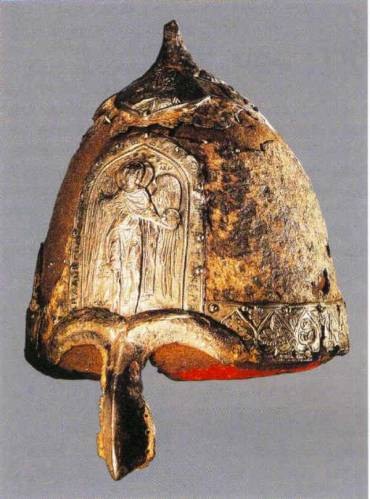 The well-known helmet of Yaroslav Vsevolodovich, thrown by him on the battlefield of Lipetsk in 1216, belongs to this type of helmet. It is an excellent example of Russian weapons and jewelry of the XII-XIII centuries. The tradition has affected the overall shape of the helmet, but technically it is very different from the helmets of the 9th-10th centuries. Its entire body is forged from one piece, and not riveted from separate plates. This made the helmet significantly lighter and stronger. Even more skill was required from the master gunsmith. An example of jewelry work in the weapons technology of the XII-XIII centuries is, as is believed, the light steel hatchet of Prince Andrei Bogolyubsky. The surface of the metal is covered with notches, and on these notches (in the hot state) sheet silver is stuffed, on top of which an ornament is applied with engraving, gilding and niello. Oval or almond-shaped shields were made of wood with an iron core and iron fittings.
The well-known helmet of Yaroslav Vsevolodovich, thrown by him on the battlefield of Lipetsk in 1216, belongs to this type of helmet. It is an excellent example of Russian weapons and jewelry of the XII-XIII centuries. The tradition has affected the overall shape of the helmet, but technically it is very different from the helmets of the 9th-10th centuries. Its entire body is forged from one piece, and not riveted from separate plates. This made the helmet significantly lighter and stronger. Even more skill was required from the master gunsmith. An example of jewelry work in the weapons technology of the XII-XIII centuries is, as is believed, the light steel hatchet of Prince Andrei Bogolyubsky. The surface of the metal is covered with notches, and on these notches (in the hot state) sheet silver is stuffed, on top of which an ornament is applied with engraving, gilding and niello. Oval or almond-shaped shields were made of wood with an iron core and iron fittings.
A special place in blacksmithing and weapons business was occupied by steel and hardening of steel products. Even among the village kurgan axes of the 11th-13th centuries, a welded-on steel blade is found. Steel's hardness, flexibility, easy weldability and ability to accept hardening were well known to the Romans. But hardfacing steel has always been considered the most difficult task in all blacksmithing, because. iron and steel have different welding temperatures. Steel hardening, i.e. more or less rapid cooling of a red-hot object in water or in another way is also well known to the ancient blacksmiths of Russia. Urban blacksmithing was distinguished by a variety of techniques, the complexity of the equipment and the many specialties associated with this production. In the XI-XIII centuries, urban craftsmen worked for a wide market, i.e. production is on the rise.
The list of urban artisans includes ironsmiths, domniks, gunsmiths, armor makers, shield makers, helmet makers, arrow makers, locksmiths, and nail makers. In the XII century, the development of the craft continues. In metal, Russian masters embodied a bizarre mixture of Christian and archaic pagan images, combining all this with local Russian motifs and plots. Improvements continue in the craft technique aimed at increasing the mass production. Posad craftsmen imitate the products of court craftsmen. In the XIII century, a number of new craft centers were created with their own characteristics in technology and style.
But we do not observe any decline in the craft from the second half of the 12th century, as it is sometimes asserted, either in Kiev or in other places. On the contrary, culture grows, covering new areas and inventing new techniques. In the second half of the 12th century and in the 13th century, despite the unfavorable conditions of feudal fragmentation, Russian craft reached the most complete technical and artistic flourishing. The development of feudal relations and feudal ownership of land in the XII - the first half of the XIII century. caused a change in the form of the political system, which found its expression in feudal fragmentation, i.e. creation of relatively independent states-principalities. During this period, blacksmithing, plumbing and weapons, forging and stamping continued to develop in all principalities. In rich farms, more and more plows with iron shares began to appear. Masters are looking for new ways of working. In the 12th - 13th centuries, Novgorod gunsmiths, using new technology, began to manufacture saber blades of much greater strength, hardness and flexibility.
Many iron products of Ancient Russia were made using the metallurgical "package" technique, in which soft iron plates were welded from the sides of the steel strip. Products made using this technique, such as knives, were grinded primarily from the sides, and the steel blade always protruded and seemed to be self-sharpening, keeping its sharpness for a long time. Of course, such knives were also sharpened, as well as other similar products made using the same technique, but their working qualities lasted longer. It can be noted that finds of stone whetstones are common in the urban layers.
The technique of "package" originated in antiquity. Things made in this way are known in Scandinavia, Czechoslovakia, and in Russia - in the antiquities of the "druzhina" type.
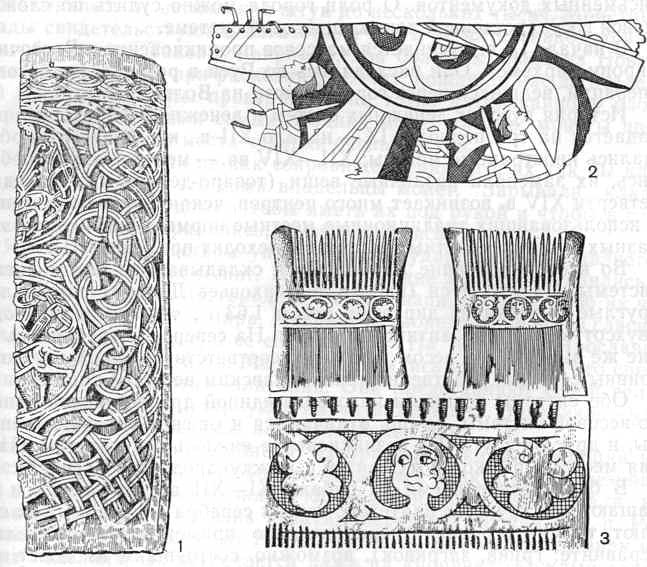
Among the items made by ancient Russian blacksmiths, there are many complex ones, consisting of many details. These are, for example, locks, in the production of which it was necessary to produce about 40 parts using various technologies. This required the ability to weld iron with steel, to master furnace soldering with copper, etc. Russian castles were also famous abroad, they are found, for example, in Czechoslovakia.
In the processing of non-ferrous and precious metals, the artisans of Ancient Russia also proved to be skilled craftsmen. Many jewelry workshops were found, where mass inexpensive jewelry was produced, especially in Novgorod. Among the materials used, copper is common, from which wire and plate blanks were made. There are also ornamental stones, such as amber. Bronze-casters' products, which required complex manufacturing techniques, were widely used. The casting method was also used to make weapons common at that time - maces and flails, as well as other things.
Beautiful Russian jewelry, the center of production of which was Kiev. Gold or silver things were decorated with granulation, filigree, cloisonné enamel. Corollas, neck chains made of medallions, kolts - figured boxes - part of a woman's outfit were made of gold with enamel. The niello was used for silver items and consisted in covering the design with a special composition of black matte color. Blackened made bracelets and kolts. A birch-bark letter was found in Novgorod, in which a noble woman demands the urgent execution of her order for gold kolts. She reports that she gave the master the metal, the weight of which is indicated in the letter. Similar jewels from the turn of the XI-XII centuries. were made, apparently, by patrimonial artisans and, as shown above, to order.
Especially many kolts, bracelets and other jewelry were found in Kiev, where most of them were buried during the raids of nomads and when the Mongol-Tatar hordes approached. The owners of these treasures either died while defending Kiev, or could not find their treasures in the conflagration. There are about 50 treasures buried between 1170 and 1240 on the territory of Kiev. One of them, and not the richest, was found at the Church of the Tithes and consisted of six silver money hryvnias of the Kiev type, two gold cloisonné enamel kolts, two gold chains, seven gold earrings, a twisted silver bracelet, five silver rings. Treasures are also known in other places of the Kiev land, Volyn, Chernigov, Novgorod-Seversky principalities, Old Ryazan, in Vladimir, Moscow and other cities and lands. In Novgorod, Smolensk, Pskov, Polotsk, i.e., cities that were not besieged by the hordes of Batu, there are no clothing treasures.
The history of Russian glassmaking has been well studied thanks to the use of the spectral analysis method. For a long time it was believed that glass products, found in ancient Russian cities and mounds, for the most part imported. Now we managed to find out that from the end of the XI century. glass-making workshops began to spread widely in Russia. They made glass beads, bracelets, vessels, window glass. The most frequent decoration of ancient Russian townswomen in the XII-XIII centuries. there were glass bracelets: yellow, green, blue, blue, purple, brown, black. There are also two colors. For example, a black bracelet is intertwined with a yellow glass thread. In Smolensk, technological methods were mastered for the production of red ("liver") glass and red glaze on ceramic products. In Kiev, a workshop for the production of glass bracelets was excavated, there were found furnaces and crucibles for melting glass. Glass was also made in a number of other ancient Russian cities. The Mongol-Tatars destroyed these cities, and with them the craft workshops (imported glass products are also not uncommon in Russia, for example, oriental beads). In Novgorod, Smolensk and some other cities, glass production continued even after the invasion, but the maximum rise in this production was already behind. The widespread production of glass was an important technical achievement of pre-Mongol Rus, which did not flourish further due to the deep decline caused by the Mongol-Tatar ruin.
Pottery occupied a prominent place among the crafts. Its heyday is associated with the advent of the potter's wheel. As explained above, the potter's wheel appears at a certain stage social development society and marks the separation of craft from agriculture. Therefore, the discovery of circular potsherds at some settlement indicates that it was at the stage of transformation into a city. The time of the appearance of the potter's wheel in Russia is from 900 to 920-930. However, until the XI century. it only existed in major cities, of those mentioned in the annals under the 9th century.
The potters produced clay products of various shapes: pots, bowls, frying pans, lamps, toys and much more. Pottery kilns for firing dishes have been found in Kiev, Staraya Ryazan, Belgorod, and elsewhere. about 2 m long. It had, as it were, two floors: the lower one was for the furnace, the upper one was for firing dishes. It preserved 26 pots that were fired there. In pottery, as well as in metalworking and others, there was a specialization. From the 10th century brick appeared in Russia, the production of which, apparently, was not without Byzantine influence. The forms of Byzantine and Russian bricks are similar. A brick in Ancient Russia was almost a square with a side of about 30 cm. Its initial thickness was 2.5 cm, then it gradually increased, and the square turned into a rectangle. Architectural historians and archaeologists call such a brick the Greek word "plinth". Two perfect brick kilns of the 12th century. found in Smolensk, where many brick churches were built. The kilns are round, cut into the mountainside, built of burnt and raw bricks. Both of them were two-tiered. The plinths were fired in the upper tier. A similar oven was discovered in Kiev near St. Sophia Cathedral and in some other places.
[Fig. 1] Products of ancient Russian artisans: 1 - a wooden vessel made on a lathe, 2 - a circular vessel, 3 - leather shoes (piston), 4 - a shoe last, 5 - a cylindrical lock, 6 - kolts, 7 - a mold for castings of imitation of kolt, 8 - grained crescent
The potters also made bright glazed tiles, which decorated the floors of some buildings, roof tiles, and artistic clay items. In Kiev, clay pysanky eggs were produced, decorated with a glazed pattern resembling curly braces. In Smolensk, they made clay, covered with multi-colored glaze with the same pattern, the handles of table knives - part of the ceremonial device. A workshop was opened in Novgorod, where they made rattles in the form of birds, covered with yellow watering. These products were widely sold and are found not only in Russia.
Old Russian townspeople wore mostly leather shoes: no sandals were found during the excavations. Leather shoes and boots, as well as other leather items - knife sheaths, purses, saddles - are decorated with a pattern of holes, embossed wickerwork or appliqués. In Novgorod, a tanner's hut was opened, to which a box with the remains of lime and wool was attached. Lime was used to remove wool from hides.
Wood chips abound in the cultural layer of ancient Russian cities - a trace of the work of carpenters. Woodworking was also done by turners, who undoubtedly existed from the 10th century. Since that time, there are wooden bowls carved on a lathe, which is structurally related to the potter's wheel and appears after it. Found all parts lathe. Turned bowls are often covered artistic carving. She decorated not only dishes, but also furniture, boats, houses. On two carved columns from Novgorod, a complex pattern in the form of intertwining ribbons is carved, framing medallions, in the centers of which centaurs are depicted. Probably, these columns were used in the construction of the house. The platbands of the windows were also decorated with carvings.
Magnificent specimens found in ancient Russian cities applied arts, products made of wood, bone, stone, non-ferrous and ferrous metal. There are several tens of thousands of them in Novgorod. Numerous carved stone slabs were found in the ancient buildings of Kiev. Particularly remarkable are the monumental reliefs on slabs of beautiful stone - slate. One of them shows two equestrian figures, perhaps portraits of princes Yaroslav and Izyaslav. As a result of the excavations, the applied art of Ancient Russia appeared before us, as it were, anew.
[Fig.2] art products: 1 - carved column, 2 - drawing on a wooden plate, 3 - wooden (boxwood) comb
Avdusin D. A. Fundamentals of archeology: Proc. for universities, according to special "Story". - M.: Higher. school, 1989. - 335 p.: ill.
ISBN 5-06-000015-X
Ancient Russia in the medieval world was widely famous for its craftsmen. At first, among the ancient Slavs, the craft was domestic in nature - everyone dressed skins for themselves, tanned leather, weaved linen, sculpted pottery, made weapons and tools. Then the artisans began to engage only in a certain trade, preparing the products of their labor for the entire community, and the rest of its members provided them with agricultural products, furs, fish, and animals. And already in the period of the early Middle Ages, the production of products on the market began. At first it was custom-made, and then the goods began to go on free sale.
Talented and skilled metallurgists, blacksmiths, jewelers, potters, weavers, stone-cutters, shoemakers, tailors, representatives of dozens of other professions lived and worked in Russian cities and large villages. These ordinary people made an invaluable contribution to the creation of the economic power of Russia, its high material and spiritual culture.
The names of the ancient artisans, with few exceptions, are unknown to us. Objects preserved from those distant times speak for them. These are both rare masterpieces and everyday things, in which talent and experience, skill and ingenuity are invested.
Blacksmiths were the first ancient Russian professional artisans. The blacksmith in epics, legends and fairy tales is the personification of strength and courage, goodness and invincibility. Iron was then smelted from swamp ores. Ore was mined in autumn and spring. It was dried, fired and taken to metal-smelting workshops, where metal was obtained in special furnaces. During excavations of ancient Russian settlements, slags are often found - waste products of the metal-smelting process - and pieces of ferruginous bloom, which, after vigorous forging, became iron masses. The remains of blacksmith workshops were also found, where parts of forges were found. The burials of ancient blacksmiths are known, in which their tools of production - anvils, hammers, tongs, chisels - were placed in their graves.
Old Russian blacksmiths supplied plowmen with coulters, sickles, scythes, and warriors with swords, spears, arrows, battle axes. All that was necessary for the economy - knives, needles, chisels, awls, staples, fish hooks, locks, keys and many other tools and household items - were made by talented craftsmen.
Old Russian blacksmiths
Old Russian blacksmiths achieved special art in the production of weapons. Items found in the burials of Chernaya Mohyla in Chernigov, necropolises in Kiev and other cities are unique examples of ancient Russian crafts of the 10th century.
A necessary part of the costume and attire of an ancient Russian person, both women and men, were various jewelry and amulets made by jewelers from silver and bronze. That is why clay crucibles, in which silver, copper, and tin were melted, are often found in ancient Russian buildings. Then the molten metal was poured into limestone, clay or stone molds, where the relief of the future decoration was carved. After that, an ornament in the form of dots, cloves, circles was applied to the finished product. Various pendants, belt plaques, bracelets, chains, temporal rings, rings, neck torcs - these are the main types of products of ancient Russian jewelers. For jewelry, jewelers used various techniques - niello, granulation, filigree filigree, embossing, enamel.
The blackening technique was rather complicated. First, a “black” mass was prepared from a mixture of silver, lead, copper, sulfur and other minerals. Then this composition was applied to bracelets, crosses, rings and other jewelry. Most often depicted griffins, lions, birds with human heads, various fantastic animals.
Graining required completely different methods of work: small silver grains, each of which was 5-6 times smaller than a pinhead, were soldered to the smooth surface of the product. What labor and patience, for example, was worth soldering 5,000 such grains to each of the kolts that were found during excavations in Kiev! Most often, granulation is found on typical Russian jewelry - lunnitsa, which were pendants in the form of a crescent.
If instead of grains of silver, patterns of the finest silver, gold wires or strips were soldered onto the product, then a filigree was obtained. From such threads-wires, sometimes an incredibly intricate pattern was created.
The technique of embossing on thin gold or silver sheets was also used. They were strongly pressed against a bronze matrix with the desired image, and it was transferred to a metal sheet. Embossing performed images of animals on kolts. Usually it is a lion or a leopard with a raised paw and a flower in its mouth. Cloisonne enamel became the pinnacle of ancient Russian jewelry craftsmanship.
The enamel mass was glass with lead and other additives. Enamels were of different colors, but red, blue and green were especially loved in Russia. Enamel jewelry went through a difficult path before becoming the property of a medieval fashionista or a noble person. First, the entire pattern was applied to the future decoration. Then a thin sheet of gold was applied to it. Partitions were cut from gold, which were soldered to the base along the contours of the pattern, and the spaces between them were filled with molten enamel. The result was an amazing set of colors that played and shone under the sun's rays in different colors and shades. The centers for the production of jewelry from cloisonné enamel were Kiev, Ryazan, Vladimir...
And in Staraya Ladoga, in the layer of the 8th century, an entire industrial complex was discovered during excavations!
And in Staraya Ladoga, in the layer of the 8th century, an entire industrial complex was discovered during excavations! The ancient Ladoga residents built a pavement of stones - iron slags, blanks, production wastes, fragments of foundry molds were found on it. Scientists believe that a metal-smelting furnace once stood here. The richest treasure trove of handicraft tools, found here, is apparently associated with this workshop. The hoard contains twenty-six items. These are seven small and large pliers - they were used in jewelry and iron processing. A miniature anvil was used to make jewelry. An ancient locksmith actively used chisels - three of them were found here. Sheets of metal were cut with jewelry scissors. Drills made holes in the tree. Iron objects with holes were used to draw wire in the production of nails and rook rivets. Jewelry hammers, anvils for chasing and embossing ornaments on silver and bronze jewelry were also found. Finished products of an ancient craftsman were also found here - a bronze ring with images of a human head and birds, rook rivets, nails, an arrow, knife blades.
Finds at the settlement of Novotroitsky, in Staraya Ladoga and other settlements excavated by archaeologists indicate that already in the 8th century the craft began to become an independent branch of production and was gradually separated from agriculture. This circumstance was of great importance in the process of the formation of classes and the creation of the state.
If for the 8th century we know so far only a few workshops, and in general the craft was of a domestic nature, then in the next, 9th century, their number increases significantly. Masters now produce products not only for themselves, their families, but for the entire community. Long-distance trade relations are gradually strengthening, various products are sold on the market in exchange for silver, furs, agricultural products and other goods.
In the ancient Russian settlements of the 9th-10th centuries, archaeologists have unearthed workshops for the production of pottery, foundry, jewelry, bone carving and others. The improvement of labor tools, the invention of new technology made it possible for individual members of the community to produce alone various things necessary for the household, in such quantities that they could be sold.
The development of agriculture and the separation of crafts from it, the weakening of tribal ties within communities, the growth of property inequality, and then the emergence of private property - the enrichment of some at the expense of others - all this formed a new mode of production - feudal. Together with him, the early feudal state gradually arose in Russia.
Partner News
The ancient crafts of Russia are one of the pillars on which the original culture of our state relies. They originate in primitive society, when all activity was collective, and the tools of labor were the simplest. However, already in those days, our ancestors were characterized by the desire for beauty. Tools and household items created jointly were decorated with ornaments, they were given a special shape. As a rule, everything, as they would say now, decorative elements possessed magical properties: protected, attracted good luck. East Slavs were similar in this regard to other tribes. The ancient crafts of Russia were distinguished by special techniques and techniques, original motives. By the time of the creation of the Kiev state, our ancestors were already masters in many types of applied art.
Blacksmith - craftsman and sorcerer
About what ancient crafts in Russia enjoyed special honor, it is easy to understand from numerous legends, legends and sayings. Often in stories there is a blacksmith who makes a miracle sword for the hero, often he is endowed with magical abilities and wisdom.
Metalworking in Russia was indeed one of the most sought-after skills. She was one of the first to stand out in an independent craft. The blacksmith was revered and respected, and iron was considered a protective material, capable of proper processing and respectful attitude to him to protect his master not only from evil people but also from evil spirits.
The development of handicraft in Kievan Rus reached amazing heights: our ancestors knew almost all modern types of metal processing. Most often, forging, filigree, niello, casting and chasing were used.
fine art
Jewelery deserves special mention. It also reached significant heights in Russia. Favorite techniques were the already mentioned filigree (filigree), niello, as well as granulation and enamel (finift). The creation of the masters of the times of Kievan Rus and later sometimes amaze. For example, enamel resembled a mosaic with such a carefully written pattern that in the eyes of the captured heroes one could distinguish a dark pupil and a light protein. Similar paintings were created from pieces of colored glass. They were pounded and mixed with a small amount of water. The resulting mass was filled into the details of the products and then they were baked several times. As a result, the enamel was fused to the metal.
Metallic lace and splatter
The filigree was an openwork ornament made of the finest gold or silver wire. In this technique, various jewelry, caskets and some other household items were made. Filigree gave them airiness and special lightness. Without exaggeration, such products can be called made of metal lace. 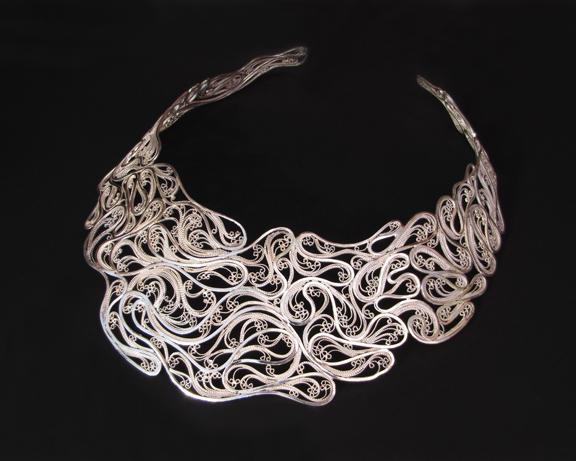
Grain was also a frequent decoration of various products. It looked like tiny drops sprinkled on the surface of the jewelry. The skill of the craftsmen knew no bounds: the thickness of the balls often did not exceed 0.4 mm. 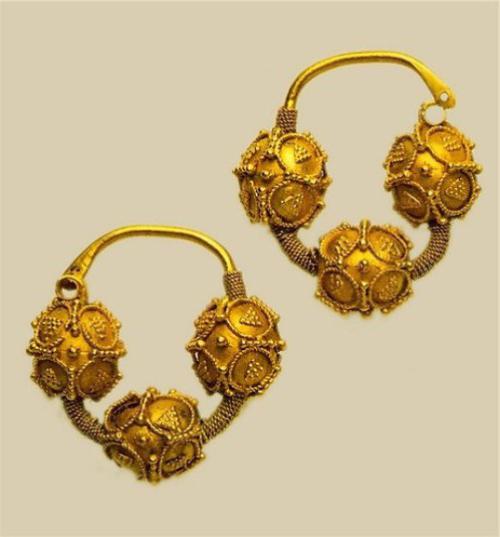
Niello was an alloy of silver and sulfur. When making jewelry, a pattern was scratched on a metal blank. Then everything was filled with black and sent to bake. Under the action of high temperature, the alloys were combined, the pattern was filled with a mixture of sulfur and silver. After that, the master only had to remove the extra parts of the niello. The resulting products were distinguished by the contrast of the noble brilliance of the metal and the matte surface of the pattern.
Clay work
The second time appearance after metal processing in Russia was pottery. Initially, dishes and other utensils were molded by hand. However, crafts in Russia developed rapidly, and in the 9th-10th centuries. The Slavs already used the potter's wheel. As a result, clay products spread throughout the state. Pottery workshops are no longer a rarity. Each of them created products that were somewhat different from the creations of other artisans. The masters adhered, in modern terms, to their own style. The differences could relate to technological issues: the temperature and time of firing, the composition of the clay, or the decor: the colors used, shape features, and various additional decorating elements.
Crafts in Russia with the adoption of Christianity began to develop according to Orthodox canons. Potters, in addition to traditional toys and utensils, began to make various items necessary for the church, and tiles - decorative tiles that were used as decoration.
live stuff
It is difficult to imagine the ancient crafts of Russia without woodcarving. It also arose from our ancestors a very long time ago. Toys and furniture, interior items and dwellings were decorated with carvings. Wood was considered a warm, living material. Like metal, it was able to protect, save from trouble, therefore wooden crafts met in the ancient state everywhere. The accessibility of the material played a huge role in this. Dwellings were built from wood, spinning wheels and spindles, toys and cradles, sledges and arcs were made. At all times in Russia, he was treated with great honor. The master tried to understand the soul contained in a piece of wood, and, creating an everyday or sacred object, to reveal it to the maximum without adding too much of himself. 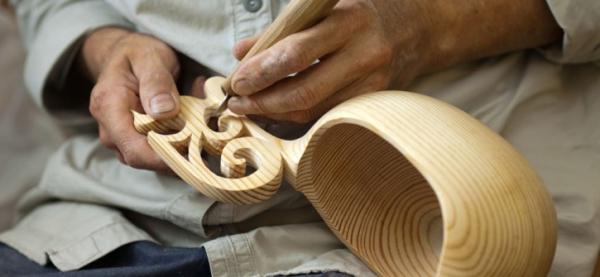
Novgorodians were considered the most skillful carvers. In the territory ancient city some time ago, an impressive monument of wooden architecture was found: an eleven-meter column dating from the 11th century. Along the entire length it is decorated with carvings, the motifs of which are never repeated.
Forgotten tricks
As often happens, with the advent of new materials and technologies, outdated knowledge fades into the background, sometimes completely lost, sometimes it remains only in the form of rare products that have not been destroyed by time. Many crafts of Kievan Rus became impoverished in this way. For example, today few people know that woodcarving, having risen to the service of Christianity, was used not only to create interior and exterior decoration of church interiors. Masters made iconostases and icon cases - this is a fairly well-known fact. The art of wooden icon painting has been lost in time. Very little is known today about the creation of images of saints using woodcarving.
Stone craftsmen
Crafts in Russia were associated with a variety of materials common in the territory. In addition to those already mentioned, the craftsmen used stone. Products from it were not inferior in elegance and beauty to wooden creations. buildings were decorated, most often built of white limestone, slate or marble. Rarely found on smaller objects. In Russia, bone combs were common, as well as icons. Masters worked on the creation of small images of saints. Such icons could be worn around the neck, hung on a strap. Often, stone carving complemented church tiles.
The position of the masters
Ancient crafts in Russia were valued differently. They were divided into two groups. The revered ones included jewelry (goldsmithing), icon painting and some others. Among the "dirty" belonged, for example, pottery.
In most cases, craftsmen worked to order. Artisans belonged to different strata of society. Free craftsmen could be found in the cities. They were engaged in blacksmithing, jewelry, chasing and icon painting. Dependent artisans, serfs lived in princely and boyar courts, estates and estates. Various masters could also be found in the monasteries.
Creations of female hands
It was in the monasteries that such ancient crafts of Russia as sewing and weaving developed most of all. They were run by women. The products of craftswomen of that time still amaze with their beauty today. Fabrics were made from hemp, linen or wool. The fabric production process became much easier with the advent of the horizontal loom. It happened at the turn of the 12th and 13th centuries.
A common type of women's needlework was patterned weaving: broken, embroidery on canvas, "silk hooping" (embedding using hoops), and so on. Craftswomen decorated household items with various patterns. Old Russian sewing was often exported by merchants to other countries. There it also enjoyed universal admiration.
temporary decline
The heyday in history is most often replaced by years, and sometimes centuries of decline. It was in this state that the crafts of Russia in the 14th century were, during the most lasting rule of the Mongol-Tatar khans. Many masters died during the battles, in an attempt to defend their native cities. During the existence of the Mongol-Tatar yoke in Russia, the development of jewelry was almost completely suspended, the production of enamel, filigree and granulation ceased. Other crafts suffered no less. However, the revival of applied art began in the next, 15th century.
Bloom again
The period from the 15th to the 17th century was the time for the strengthening of the new Russian state. Moscow was the center of unification of principalities. Ancient crafts that existed in Russia for centuries began to gain strength again. The nobility sought to surround themselves with exquisite objects, luxury and wealth. Craftsmen came to the court of the prince, and then the king, who were engaged in stone or wood carving, weaving and embroidery, and jewelry.
Commodity-money relations are also developing. As a result, crafts in Russia in the 16th century became the main source of income for residents of many cities. Handicraft art crafts are gradually formed. The oldest among them is considered to have arisen in the 16-17 centuries in the Trinity-Sergius Monastery. Here, the craftsmen were engaged in wood and bone carving, and a little later, toy craft arose.
world star
After the 15th century, almost all crafts in Russia began to actively develop. For children, Khokhloma painting and Dymkovo toys are especially familiar among them. These types of artistic crafts are still very popular today, not only in our country, but also abroad.
Khokhloma enriched crafts in Russia in the 17th century. This type of painting was used to decorate various furniture. Khokhloma is well recognizable thanks to the traditional color scheme: red, black and green on a gold background. The masters of painting had their secrets. For example, for the background on wooden blank not gold powder was applied, but a mixture of tin and silver. The item was then covered special composition and baked several times in the oven. Thus, the desired golden hue was achieved. Khokhloma painting always completely covered the product: the tree was not noticeable at all. 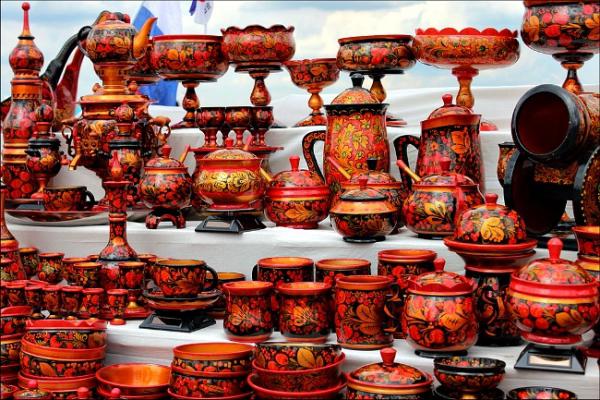
Bright and unique
Another famous art craft, originating, apparently, during this period - it received its name from the place of origin. Kirov settlement Dymkovo was famous for its red clay. All over the world there are no products similar to a bright and cheerful toy. Interestingly, the production technology is quite simple, and if desired, such a figurine can be made independently. 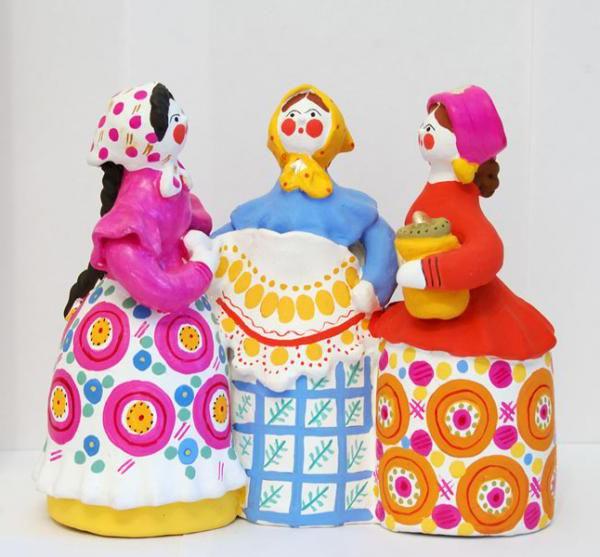
The crafts of Ancient Russia are not forgotten today. You could even say that they are going through a new stage of development. There is a renewed interest in folk traditions ancient times: beliefs, costume, customs and arts and crafts. Crafts are actively studied both in the relevant specialties at universities and independently. Needlework is in great demand today, and therefore craftsmen are happy to turn to traditional crafts. At the same time, the technology undergoes various changes: new compositions, paints, bases and fixers are used, in some cases - electrical devices. On the other hand, in some cases the whole remains unchanged.
It should be noted that the study of the question of what crafts developed in Russia is important for understanding the original Russian culture, helping to imbue it with the spirit. The revival of interest in this topic indicates the relevance of such processes. It can be said that crafts in Russia (photos of products that fill the Internet in many, only confirm this) are still alive and continue to develop.


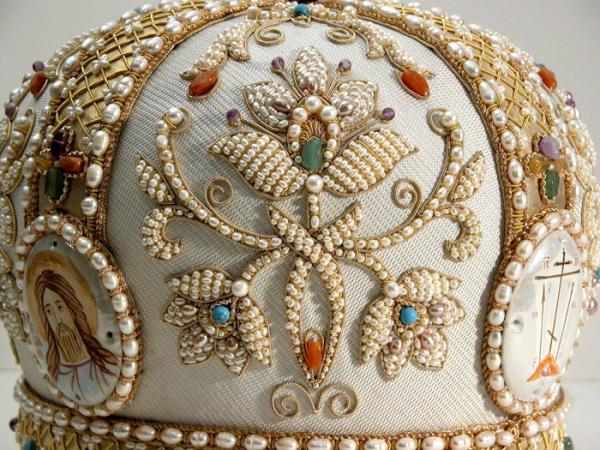










How to understand: will the kitten be fluffy?
What kind of light alcohol can be drunk for pregnant women: the consequences of drinking
Why do the legs swell in the ankles and ankles of the feet in pregnant women: causes and methods of treatment
The wedding of Prince Harry and Meghan Markle: scandalous and secret details of the marriage (photo) The future marriage of Prince Harry year NTV
How to close white plums for the winter